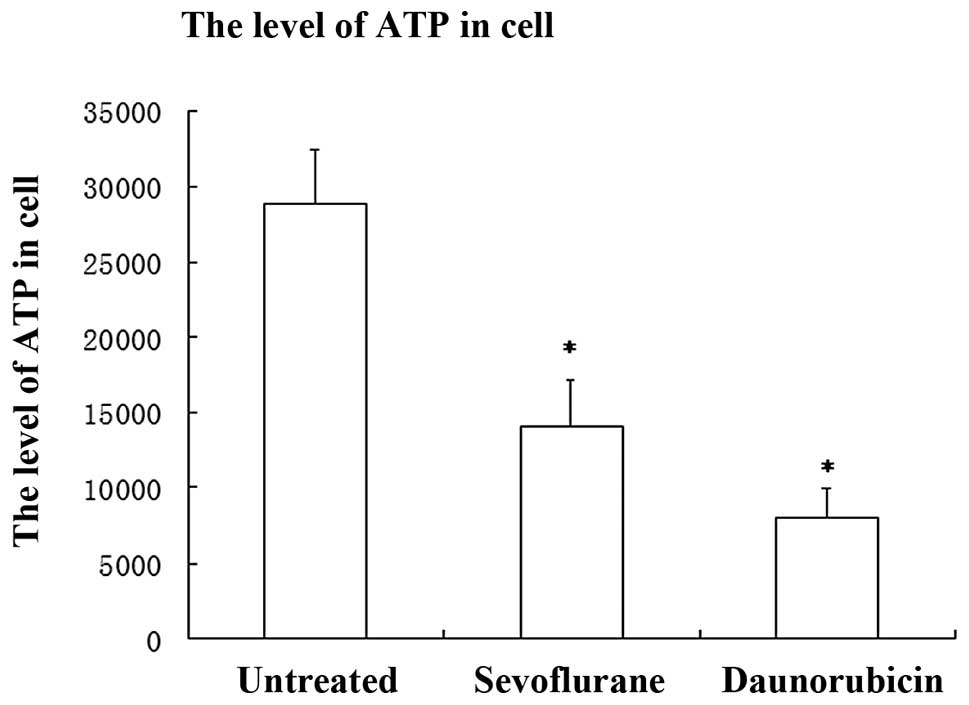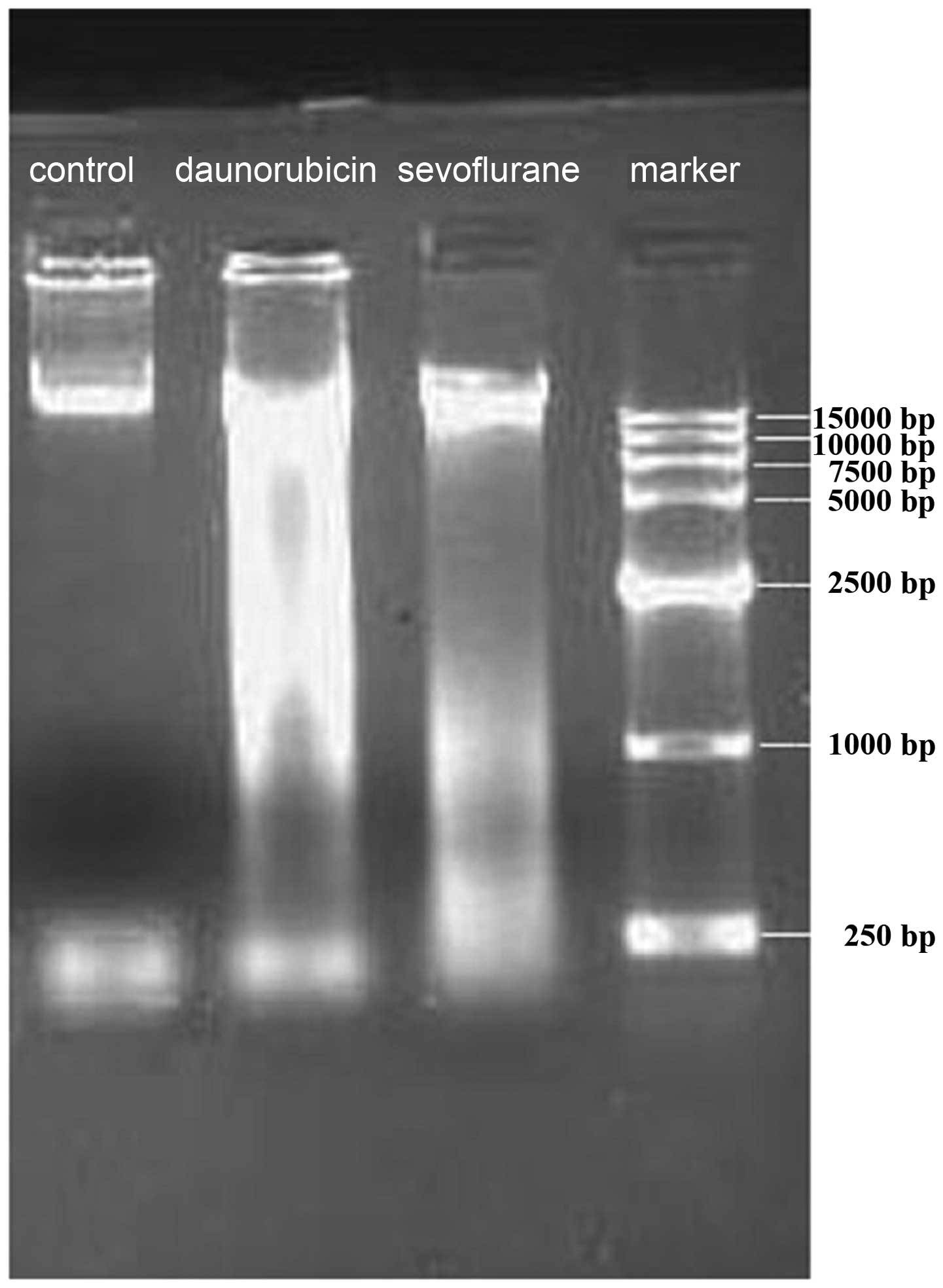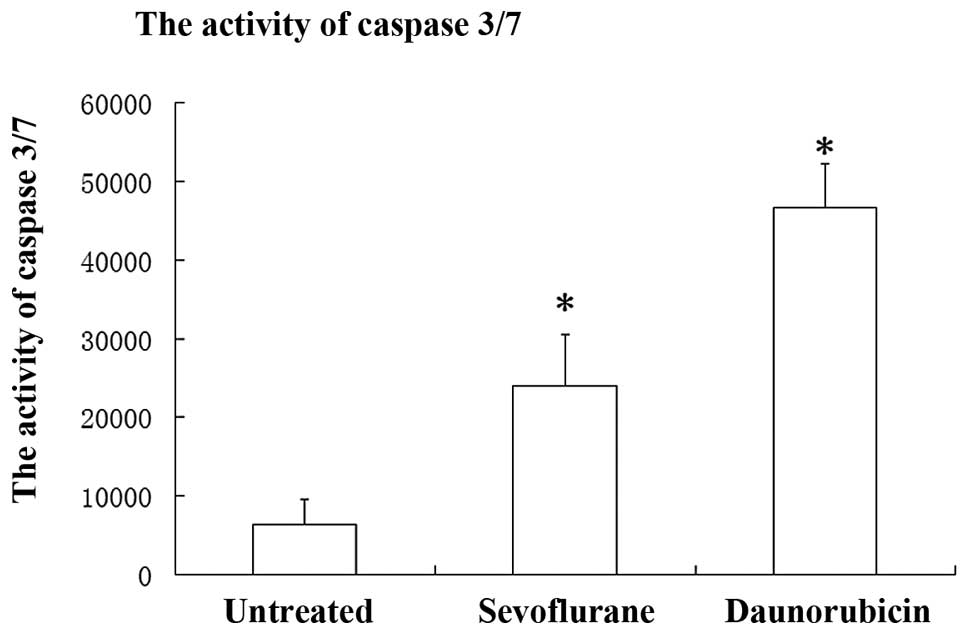|
1
|
Tang J, Eckenhoff MF and Eckenhoff RG:
Anesthesia and the old brain. Anesth Analg. 110:421–426. 2010.
View Article : Google Scholar : PubMed/NCBI
|
|
2
|
Terrando N, Brzezinski M, Degos V,
Eriksson LI, Kramer JH, Leung JM, Miller BL, Seeley WW, Vacas S,
Weiner MW, et al: Perioperative cognitive decline in the aging
population. Mayo Clin Proc. 86:885–893. 2011. View Article : Google Scholar : PubMed/NCBI
|
|
3
|
Wu X, Lu Y, Dong Y, Zhang G, Zhang Y, Xu
Z, Culley DJ, Crosby G, Marcantonio ER, Tanzi RE and Xie Z: The
inhalation anesthetic isoflurane increases levels of
proinflammatory TNF-α, IL-6, and IL-1β. Neurobiol Aging.
33:1364–1378. 2012.
|
|
4
|
Xie Z and Tanzi RE: Alzheimer’s disease
and post-operative cognitive dysfunction. Exp Gerontol. 41:346–359.
2006.
|
|
5
|
Xu Z, Dong Y, Wu X, Zhang J, McAuliffe S,
Pan C, Zhang Y, Ichinose F, Yue Y and Xie Z: The potential dual
effects of anesthetic isoflurane on Aβ-induced apoptosis. Curr
Alzheimer Res. 8:741–752. 2011.
|
|
6
|
Lu Y, Wu X, Dong Y, Xu Z, Zhang Y and Xie
Z: Anesthetic sevoflurane causes neurotoxicity differently in
neonatal naive and Alzheimer disease transgenic mice.
Anesthesiology. 112:1404–1416. 2010. View Article : Google Scholar : PubMed/NCBI
|
|
7
|
Pollock RE, Lotzová E and Stanford SD:
Surgical stress impairs natural killer cell programming of tumor
for lysis in patients with sarcomas and other solid tumors. Cancer.
70:2192–2202. 1992. View Article : Google Scholar : PubMed/NCBI
|
|
8
|
Salo M: Effects of anaesthesia and surgery
on the immune response. Acta Anaesthesiol Scand. 36:201–220. 1992.
View Article : Google Scholar : PubMed/NCBI
|
|
9
|
Loop T, Dovi-Akue D, Frick M, Roesslein M,
Egger L, Humar M, Hoetzel A, Schmidt R, Borner C, Pahl HL, et al:
Volatile anesthetics induce caspase-dependent,
mitochondria-mediated apoptosis in human T lymphocytes in vitro.
Anesthesiology. 102:1147–1157. 2005. View Article : Google Scholar : PubMed/NCBI
|
|
10
|
Matsuoka H, Kurosawa S, Horinouchi T, Kato
M and Hashimoto Y: Inhalation anesthetics induce apoptosis in
normal peripheral lymphocytes in vitro. Anesthesiology.
95:1467–1472. 2001. View Article : Google Scholar : PubMed/NCBI
|
|
11
|
Delogu G, Moretti S, Famularo G, Antonucci
A, Signore L, Marcellini S, Lo Bosco L and De Simone C: Circulating
neutrophils exhibit enhanced apoptosis associated with
mitochondrial dysfunctions after surgery under general anaesthesia.
Acta Anaesthesiol Scand. 45:87–94. 2001. View Article : Google Scholar
|
|
12
|
Lalchev ZI: Surface properties of lipids
and proteins at bio-interfaces. Handbook of Surface and Colloid
Chemistry. Birdi KS: CRC Press; New York, NY: pp. 625–687. 1997
|
|
13
|
White MK, Baireddy V and Strayer DS:
Natural protection from apoptosis by surfactant protein A in type
II pneumocytes. Exp Cell Res. 263:183–192. 2001. View Article : Google Scholar : PubMed/NCBI
|
|
14
|
Fehrenbach H: Alveolar epithelial type II
cell: defender of the alveolus revisited. Respir Res. 2:33–46.
2001. View Article : Google Scholar : PubMed/NCBI
|
|
15
|
Watanabe N, Dickinson DA, Krzywanski DM,
Iles KE, Zhang H, Venglarik CJ and Forman HJ: A549 subclones
demonstrate heterogeneity in toxicological sensitivity and
antioxidant profile. Am J Physiol Lung Cell Mol Physiol.
283:L726–L736. 2002.PubMed/NCBI
|
|
16
|
Topouzova-Hristova T, Daza P,
Garcia-Herdugo G and Stephanova E: Volatile anaesthetic halothane
causes DNA damage in A549 lung cells. Toxicol In Vitro. 20:585–593.
2006. View Article : Google Scholar : PubMed/NCBI
|
|
17
|
Topouzová-Hristova T, Hazarosova R,
Bandreva B and Stephanova E: Halothane does not directly interact
with genome DNA of A549 cells. Folia Biol (Praha). 53:176–182.
2007.PubMed/NCBI
|
|
18
|
Stephanova E, Topouzova-Hristova T and
Konakchieva R: Mitochondria are involved in stress response of A549
alveolar cells to halothane toxicity. Toxicol In Vitro. 22:688–694.
2008. View Article : Google Scholar : PubMed/NCBI
|
|
19
|
Oka M, Hirazawa K, Yamamoto K, Iizuka N,
Hazama S, Suzuki T and Kobayashi N: Induction of Fas-mediated
apoptosis on circulating lymphocytes by surgical stress. Ann Surg.
223:434–440. 1996. View Article : Google Scholar : PubMed/NCBI
|
|
20
|
Sasajima K, Inokuchi K, Onda M, Miyashita
M, Okawa KI, Matsutani T and Takubo K: Detection of T cell
apoptosis after major operations. Eur J Surg. 165:1020–1023. 1999.
View Article : Google Scholar : PubMed/NCBI
|
|
21
|
Lieber M, Smith B, Szakal A, Nelson-Rees W
and Todaro G: A continuous tumor-cell line from a human lung
carcinoma with properties of type II alveolar epithelial cells. Int
J Cancer. 17:62–70. 1976. View Article : Google Scholar : PubMed/NCBI
|
|
22
|
Elmore S: Apoptosis: a review of
programmed cell death. Toxicol Pathol. 35:495–516. 2007. View Article : Google Scholar : PubMed/NCBI
|
|
23
|
Petty RD, Sutherland LA, Hunter EM and
Cree IA: Comparison of MTT and ATP-based assays for the measurement
of viable cell number. J Biolumin Chemilumin. 10:29–34. 1995.
View Article : Google Scholar : PubMed/NCBI
|
|
24
|
Bakand S, Winder C and Hayes A:
Comparative in vitro cytotoxicity assessment of selected gaseous
compounds in human alveolar epithelial cells. Toxicol In Vitro.
21:1341–1347. 2007. View Article : Google Scholar : PubMed/NCBI
|
|
25
|
Ghatge S, Lee J and Smith I: Sevoflurane:
an ideal agent for adult day-case anesthesia? Acta Anaesthesiol
Scand. 47:917–931. 2003. View Article : Google Scholar : PubMed/NCBI
|
|
26
|
Wong CH, Liu TZ, Chye SM, Lu FJ, Liu YC,
Lin ZC and Chen CH: Sevoflurane-induced oxidative stress and
cellular injury in human peripheral polymorphonuclear neutrophils.
Food Chem Toxicol. 44:1399–1407. 2006. View Article : Google Scholar : PubMed/NCBI
|
|
27
|
Roesslein M, Frick M, Auwaerter V, Humar
M, Goebel U, Schwer C, Geiger KK, Pahl HL, Pannen BH and Loop T:
Sevoflurane-mediated activation of p38-mitogen-activated
stresskinase is independent of apoptosis in Jurkat T-cells. Anesth
Analg. 106:1150–1160. 2008. View Article : Google Scholar : PubMed/NCBI
|
|
28
|
Mückter H, Zwing M, Bäder S, Marx T,
Doklea E, Liebl B, Fichtl B and Georgieff M: A novel apparatus for
the exposure of cultured cells to volatile agents. J Pharmacol
Toxicol Methods. 40:63–69. 1998.PubMed/NCBI
|
|
29
|
Lundin A and Thore A: Analytical
information obtainable by evaluation of the time course of firefly
bioluminescence in the assay of ATP. Anal Biochem. 66:47–63. 1975.
View Article : Google Scholar : PubMed/NCBI
|
|
30
|
Loop T, Scheiermann P, Doviakue D,
Musshoff F, Humar M, Roesslein M, Hoetzel A, Schmidt R, Madea B,
Geiger KK, et al: Sevoflurane inhibits
phorbol-myristate-acetate-induced activator protein-1 activation in
human T lymphocytes in vitro: potential role of the p38-stress
kinase pathway. Anesthesiology. 101:710–721. 2004. View Article : Google Scholar : PubMed/NCBI
|
|
31
|
Kvolik S, Glavas-Obrovac L, Bares V and
Karner I: Effects of inhalation anesthetics halothane, sevoflurane,
and isoflurane on human cell lines. Life Sci. 77:2369–2383. 2005.
View Article : Google Scholar : PubMed/NCBI
|
|
32
|
Bardales RH, Xie SS, Schaefer RF and Hsu
SM: Apoptosis is a major pathway responsible for the resolution of
type II pneumocytes in acute lung injury. Am J Pathol. 149:845–852.
1996.PubMed/NCBI
|
|
33
|
Nicholson DW: Caspase structure,
proteolytic substrates, and function during apoptotic cell death.
Cell Death Differ. 6:1028–1042. 1999. View Article : Google Scholar : PubMed/NCBI
|
|
34
|
Earnshaw WC, Martins LM and Kaufmann SH:
Mammalian caspases: structure, activation, substrates, and
functions during apoptosis. Annu Rev Biochem. 68:383–424. 1999.
View Article : Google Scholar : PubMed/NCBI
|
|
35
|
O’Neill AJ, O’Neill S, Hegarty NJ, Coffey
RN, Gibbons N, Brady H, Fitzpatrick JM and Watson RW: Glutathione
depletion-induced neutrophil apoptosis is caspase 3 dependent.
Shock. 14:605–609. 2000.PubMed/NCBI
|
|
36
|
Dong Y, Zhang G, Zhang B, Moir RD, Xia W,
Marcantonio ER, Culley DJ, Crosby G, Tanzi RE and Xie Z: The common
inhalational anesthetic sevoflurane induces apoptosis and increases
beta-amyloid protein levels. Arch Neurol. 66:620–631. 2009.
View Article : Google Scholar : PubMed/NCBI
|
|
37
|
Molliex S, Dureuil B, Aubier M,
Friedlander G, Desmonts JM and Clerici C: Halothane decreases
Na,K-ATPase, and Na channel activity in alveolar type II cells.
Anesthesiology. 88:1606–1613. 1998. View Article : Google Scholar : PubMed/NCBI
|
|
38
|
Sardaş S, Aygün N, Gamli M, Unal Y, Unal
N, Berk N and Karakaya AE: Use of alkaline comet assay (single cell
gel electrophoresis technique) to detect DNA damages in lymphocytes
of operating room personnel occupationally exposed to anaesthetic
gases. Mutat Res. 418:93–100. 1998.
|
|
39
|
Jaloszyński P, Kujawski M, Wasowicz M,
Szulc R and Szyfter K: Genotoxicity of inhalation anesthetics
halothane and isoflurane in human lymphocytes studied in vitro
using the comet assay. Mutat Res. 439:199–206. 1999.PubMed/NCBI
|
|
40
|
Patel AB, Sokolowski J, Davidson BA,
Knight PR and Holm BA: Halothane potentiation of hydrogen
peroxide-induced inhibition of surfactant synthesis: the role of
type II cell energy status. Anesth Analg. 94:943–947. 2002.
View Article : Google Scholar : PubMed/NCBI
|
|
41
|
Häcker G: The morphology of apoptosis.
Cell Tissue Res. 301:5–17. 2000.
|
|
42
|
Valtcheva R, Stephanova E, Jordanova A,
Pankov R, Altankov G and Lalchev Z: Effect of halothane on lung
carcinoma cells A 549. Chem Biol Interact. 146:191–200. 2003.
View Article : Google Scholar : PubMed/NCBI
|
|
43
|
Szyfter K, Szulc R, Mikstacki A, Stachecki
I, Rydzanicz M and Jaloszyński P: Genotoxicity of inhalation
anaesthetics: DNA lesions generated by sevoflurane in vitro and in
vivo. J Appl Genet. 45:369–374. 2004.PubMed/NCBI
|
|
44
|
Kanamoto T, Mota M, Takeda K, Rubin LL,
Miyazono K, Ichijo H and Bazenet CE: Role of apoptosis
signal-regulating kinase in regulation of the c-Jun N-terminal
kinase pathway and apoptosis in sympathetic neurons. Mol Cell Biol.
20:196–204. 2000. View Article : Google Scholar : PubMed/NCBI
|
|
45
|
Hofmann TG, Möller A, Hehner SP, Welsch D,
Dröge W and Schmitz ML: CD95-induced JNK activation signals are
transmitted by the death-inducing signaling complex (DISC), but not
by Daxx. Int J Cancer. 93:185–191. 2001. View Article : Google Scholar : PubMed/NCBI
|
|
46
|
Hatai T, Matsuzawa A, Inoshita S, Mochida
Y, Kuroda T, Sakamaki K, Kuida K, Yonehara S, Ichijo H and Takeda
K: Execution of apoptosis signal-regulating kinase 1 (ASK1)-induced
apoptosis by the mitochondria-dependent caspase activation. J Biol
Chem. 275:26576–26581. 2000. View Article : Google Scholar : PubMed/NCBI
|
|
47
|
Rithalia A, Qureshi MA, Howarth FC and
Harrison SM: Effects of halothane on contraction and intracellular
calcium in ventricular myocytes from streptozotocin-induced
diabetic rats. Br J Anaesth. 92:246–253. 2004. View Article : Google Scholar : PubMed/NCBI
|
|
48
|
Yu WF, Yang LQ, Zhou MT, Liu ZQ and Li Q:
Ca2+ cytochemical changes of hepatotoxicity caused by
halothane and sevoflurane in enzyme-induced hypoxic rats. World J
Gastroenterol. 11:5025–5028. 2005.
|
|
49
|
Lopez MM and Kosk-Kosicka D: How do
volatile anesthetics inhibit Ca(2+)-ATPases? J Biol Chem.
270:28239–28245. 1995.
|













